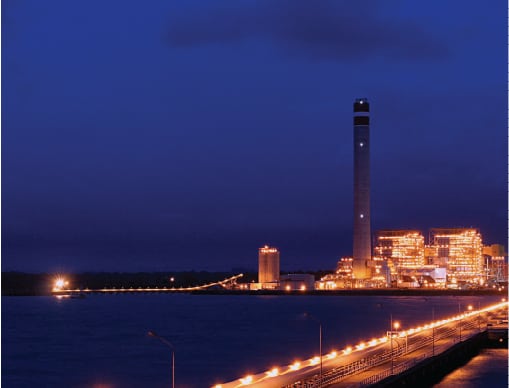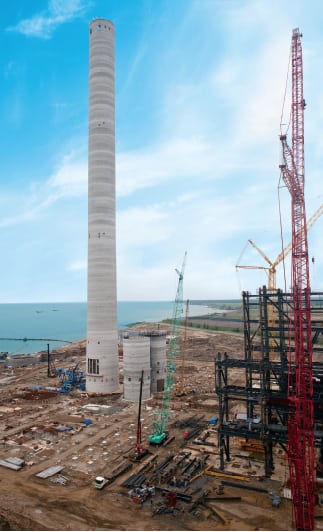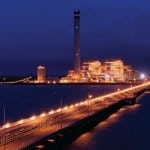 |
Units 3 and 4 expand the Tanjung Jati Electric Generating Station’s capacity by adding 1,320 MW of reliable power that helps to boost Indonesia’s growing economy. Now the 2,640-MW coal-fired facility provides approximately 12% of the electricity available on the Java-Bali grid. The new units feature a flue gas desulfurization system and electrostatic precipitators that reduce air emissions and protect the environment.
[Editor’s note, Oct. 9, 2012: The print and digital versions of this story have a slightly different headline that refers to the expansion project, which is the focus of this article; however, POWER wishes to grant the Top Plant award to the entire plant in recognition of its overall achievements, including the Blue Proper (an environmental compliance rating) granted in 2011 by the Indonesian government.]
Delivering reliable electricity to more than 238 million citizens in a country with more than 17,000 islands is no easy matter. Despite the challenges, PT PLN, the state-operated utility, is working hard to meet Indonesian electrical needs. The country is the largest economy in Southeast Asia and a member of the G-20 major economies. According to World Trade Organization data, Indonesia was the 27th biggest exporting country in the world in 2010.
The Tanjung Jati B Electric Generating Station is doing its part to carry out the national energy strategy of bolstering economic growth. Indonesia has been facing a tight electricity demand/supply situation in line with the increased electricity needs that come with economic growth. Moreover, electricity demand throughout the country is estimated to grow at an average rate of 9% per year until 2019, according to a statement released by Sumitomo Corp., one of the major contractors involved in the Tanjung Jati B plant’s expansion project.
To solve the national power shortage problem, the Indonesian government developed the first and second Tanjung Jati B construction programs in 2006 and 2010, respectively. The 660-MW Unit 3 achieved commercial operation on Oct. 13, 2011, and the 660-MW Unit 4 started operating on Jan. 1, 2012. The Tanjung Jati B expansion project is expected to help the country reach the national electrification target of 70.6% this year, equal to 2.5 million new customers.
“The electricity provision in the Central Java Province is already in surplus. However, we hope that the expanded operations of the Tanjung Jati B coal-fired power plant will bring more investment and large-scale industries to the province that, in turn, will lead to more job opportunities,” PLN President Director Nur Pamudji said in February.
 |
| 1. From the ground up. Units 3 and 4 at Tanjung Jati Electric Generating Station in Indonesia are shown during the initial construction phase. Now that the two younger sibling units are operational, they share the workload with Units 1 and 2. The 2,640-MW coal-fired power plant provides approximately 12% of the electricity available on the Java-Bali grid. Courtesy: Black & Veatch |
Overall, Indonesia still has a large need for electric power, and there are many opportunities for future generating stations, Michael W. Johnson, project manager of the Tanjung Jati B expansion project and associate vice president at Black & Veatch (B&V), told POWER in August. “The Tanjung Jati Units 3 and 4 expansion project is helping Indonesia to meet its power needs, and it also serves as a model for other developing countries throughout the world. The expanded plant generates approximately 8.5 billion kWh/year of electricity,” he said.
Expansion Project Profile
Located on a 150-hectare plot, Units 3 and 4 required a total investment of approximately $2.08 billion from the Japan Bank for International Cooperation and other commercial banks (Figure 1).
Sumitomo Corp.’s erection division performed mechanical and electrical construction for all Unit 3 and 4 areas, except the boiler island. Other major contractors for the expansion project included Mitsubishi Heavy Industries Ltd. (furnished and erected the boiler island) and Mitsui Engineering and Shipbuilding Co., Ltd. (civil construction).
The B&V-supplied equipment was erected by Sumitomo and also subcontracted to an Indonesia national contractor with Japanese supervision. Johnson noted that “China-sourced equipment supplied by B&V was not erected by a Chinese contractor,” which proved to be a challenge. Toshiba Corp. Power Systems Co., as a separate entity working for Sumitomo, provided the turbine island’s equipment, including the turbine, condenser, transformers, and distributed control system (DCS).
Despite the fact that multiple entities were involved in procurement, supply, construction, and commissioning, all construction with commissioning occurred within the time available and met all project milestone dates, Johnson said.
Promoting Top Environmental Performance
The design of Tanjung Jati Units 3 and 4 includes a flue gas desulfurization system and electrostatic precipitators to reduce air emissions. Johnson explained that, “together with the equipment installed at Units 1 and 2, the project includes some of the first examples of modernized air quality control technology at a major power plant in Asia.”
Indonesian law requires that the boiler island’s environmental control equipment at Units 3 and 4 (supplied by B&V) meet sulfur dioxide (SO2) emission limits of 300 mg/Nm3 and total particulate matter emission limits of 50 mg/Nm3 at the stack outlet. In addition, Indonesian environmental law required limestone consumption guarantees.
“The Chinese-supplied environmental control equipment, as demonstrated during performance testing, was able to achieve SO2 and particulate matter emission values significantly lower than these limits,” Johnson said. “Limestone consumption was also significantly lower than required.”
Building at an Operating Facility
Original planners of the Tanjung Jati power plant designed the site to accommodate the addition of two more units, and Units 3 and 4 are essentially independent of the first two. For example, the two new units have a separate control room.
Johnson said that B&V’s scope for the project was engineering and procurement, plus commissioning for the boiler island auxiliary equipment package. B&V was not directly responsible for construction. However, coordinating the design and equipment supply to interface with an operating facility presented challenges. B&V’s design had to ensure that there would be minimal impact to Units 1 and 2’s operations during construction and commissioning. This required consideration of the existing plant operation and maintenance requirements during the construction phase.
Johnson explained that the coal-handling system design presented a complex challenge because Unit 3 and 4’s coal storage area is on the west side of the site, although Units 3 and 4 are located east of Units 1 and 2. Therefore, coal conveyors were designed to route coal across Units 1 and 2 to reach Units 3 and 4.
The project team used a pipe conveyor to transport coal across the existing facility for minimal impact on the operation of existing units during construction and commissioning of the coal-conveying system. Johnson said, “The pipe conveyor design is such that the conveyor can make a directional change without the addition of a transfer tower and additional conveyors. Yard piping was also routed in such a way that no impact occurred to the existing facility.”
Successful Integration of Chinese Equipment
A significant project hurdle involved using Chinese equipment for the boiler island auxiliary equipment supply. Johnson said that this challenge was “amplified” by the fact that the China-sourced equipment was erected by an Indonesian erection contractor who, in turn, was supervised by Japanese contractors. In the past, Chinese contractors who were most familiar with the Chinese-sourced equipment were in charge of erecting this equipment during construction projects.
Johnson explained that prior to the Tanjung Jati expansion project the B&V project team spent several years screening and prequalifying Chinese equipment suppliers. Specifically, they focused on selecting the most qualified Chinese companies based on their ability to meet the quality, schedule, and cost requirements, and their demonstrated track record of meeting performance guarantees. During the expansion project, the B&V project team closely monitored the Chinese equipment suppliers’ performance through extensive document reviews and applying a rigorous quality review program.
One example of the challenges the B&V project team members faced was when they had to integrate some Chinese equipment control requirements with a Japanese-supplied DCS. Johnson said that resolving this problem required close communication and coordination to ensure all the Chinese equipment’s control needs were met and integrated into the overall plant DCS control requirements.
“The utilization of Chinese-sourced equipment and materials built to Chinese codes and standards for the boiler island auxiliary equipment and then integrating it with non-Chinese equipment supplied by others was quite challenging,” Johnson said. To overcome such obstacles, the Chinese equipment had to be delivered on time, erected by others, and then commissioned by B&V to support all project milestones. Fortunately, the Chinese equipment met all required performance guarantees by a significant margin, according to Johnson.
— Angela Neville, JD is POWER’s senior editor










